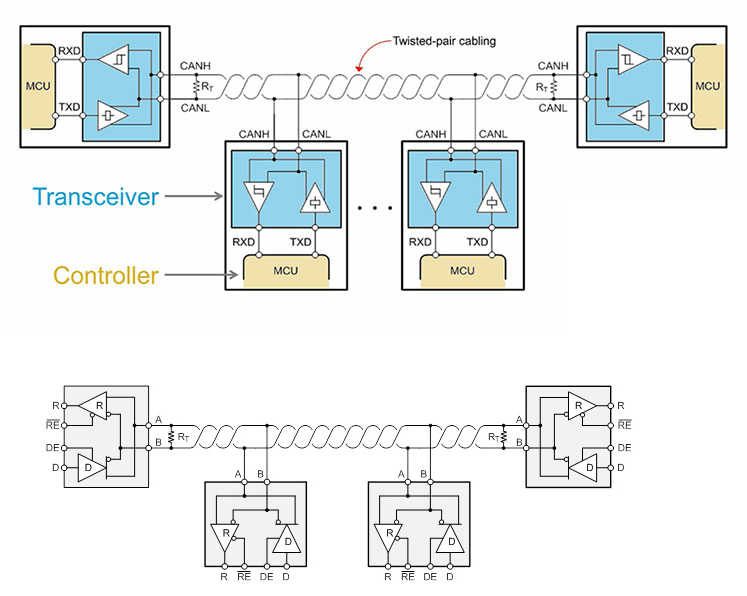
RS-485 vs. CAN Bus
Introduction
In the realm of industrial and automotive communication protocols, RS-485 and CAN bus frequently emerge as top contenders. Each system offers unique capabilities tailored for their specific use-cases, but choosing between them often poses a dilemma. By dissecting their technical specifications, error handling, speed, and cabling, we hope to provide clarity.
Historical Overview
RS-485: An evolution from the RS-232, RS-485 was designed for long-distance, multi-device communication, emphasizing improved noise resistance.
CAN Bus: Conceived by Bosch in the 1980s, CAN bus revolutionized in-vehicle communications, enabling devices to communicate without a central hub.
Technical Specifications & Cabling
RS-485
Cable: Typically uses twisted pair cabling, which boosts noise resistance.
Speed: Can achieve data rates up to 10 Mbps, though this diminishes over long distances. For instance, at 1,200 meters, expect around 100 kbps.
CAN Bus
Cable: Also utilizes twisted pair cables, with a 120-ohm characteristic impedance.
Speed: Speeds vary based on CAN specification. Classic CAN reaches up to 1 Mbps, while CAN FD (Flexible Data-rate) can go up to 5 Mbps, albeit over shorter distances.
Error Handling & Reliability
RS-485: Lacks intrinsic error-checking mechanisms. For robust error handling, users often layer additional protocols atop RS-485.
CAN Bus: Built with advanced error detection and handling in mind. If errors arise, nodes can flag them or initiate corrective actions, making CAN networks inherently more reliable.
Network Scalability & Management
RS-485: Supports up to 32 devices (1 driver and 31 receivers) on a single bus. Extending beyond this requires repeaters. However, as devices increase, managing data flow and preventing collisions becomes intricate.
CAN Bus: By focusing on message-centric communication, CAN bus inherently scales and efficiently manages vast device networks, making it adept at real-time operations across numerous nodes.
Applications & Use Cases
RS-485: Given its robustness over long distances, RS-485 excels in industrial automation, building systems (like HVAC), and point-of-sale setups. Its strength lies in systems where long, consistent communication trumps intricate data handling.
CAN Bus: Originally automotive-centric, CAN bus now permeates industrial automation, medical equipment, and aerospace industries. It's preferred where real-time, intricate data handling across various devices is paramount.
Data Integrity & Security
RS-485: Offers solid data transmission, but without built-in encryption or security features. Incorporating security necessitates external layers or protocols.
CAN Bus: Prioritizes data integrity with superior error handling. However, for encrypted communications, users must introduce higher-level protocols or supplementary systems.
Economic & Flexibility Considerations
RS-485: Its straightforward design and broad adoption make RS-485 components relatively cost-effective. While intrinsically flexible, its real versatility surfaces when integrated with complementary protocols.
CAN Bus: The specialized nature of CAN might elevate costs slightly. Yet, its inherent adaptability, driven by its message-based foundation, allows it to mold seamlessly to diverse environments without extensive modifications.
Conclusion
RS-485 and CAN bus, though similar in some facets, are distinctly tailored for different scenarios. RS-485 thrives in environments requiring reliable, long-distance communications, while CAN bus is designed for networks necessitating real-time, complex data exchanges among multiple nodes.
Your selection should pivot around your project's specific needs—network topology, real-time requirements, distance, data integrity, and budget. With their longstanding histories and proven track records, both protocols stand ready to bolster any communication-centric system.